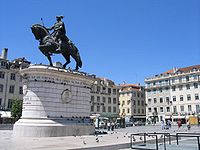
Praça da Figueira
Encyclopedia

Lisbon
Lisbon is the capital city and largest city of Portugal with a population of 545,245 within its administrative limits on a land area of . The urban area of Lisbon extends beyond the administrative city limits with a population of 3 million on an area of , making it the 9th most populous urban...
, in Portugal
Portugal
Portugal , officially the Portuguese Republic is a country situated in southwestern Europe on the Iberian Peninsula. Portugal is the westernmost country of Europe, and is bordered by the Atlantic Ocean to the West and South and by Spain to the North and East. The Atlantic archipelagos of the...
. It is part of the Baixa Pombalina, the area of the city reurbanised after the 1755 Lisbon Earthquake
1755 Lisbon earthquake
The 1755 Lisbon earthquake, also known as the Great Lisbon Earthquake, was a megathrust earthquake that took place on Saturday 1 November 1755, at around 9:40 in the morning. The earthquake was followed by fires and a tsunami, which almost totally destroyed Lisbon in the Kingdom of Portugal, and...
.
In the 16th century the square did not exist, and most of its area was occupied by the Hospital Real de Todos os Santos
Hospital Real de Todos os Santos
The Hospital Real de Todos os Santos was a major hospital in Lisbon, Portugal. The hospital was built between 1492 and 1504 and was destroyed in the 1755 Lisbon earthquake, along with most of the city.-Foundation:...
(All-Saints Royal Hospital), the most important in the city. In 1755, after the great earthquake which destroyed most of Lisbon, the hospital was greatly damaged. It was demolished around 1775.
The large area previously occupied by the hospital in the Baixa was turned into an open market square. Around 1885, a large covered market of 8,000 m² was built. This market existed until 1949, when it was demolished. Since then the square has been an open space.
In 1971 a bronze
Bronze
Bronze is a metal alloy consisting primarily of copper, usually with tin as the main additive. It is hard and brittle, and it was particularly significant in antiquity, so much so that the Bronze Age was named after the metal...
equestrian statue representing King John I
John I of Portugal
John I KG , called the Good or of Happy Memory, more rarely and outside Portugal the Bastard, was the tenth King of Portugal and the Algarve and the first to use the title Lord of Ceuta...
(1357-1433), by sculptor Leopoldo de Almeida, was inaugurated in the square. The monument also carries medallions with the effigies of Nuno Álvares Pereira
Nuno Álvares Pereira
Dom Nuno Álvares Pereira, O. Carm. , also spelled Nun'Álvares Pereira, was a Portuguese general of great success who had a decisive role in the 1383-1385 Crisis that assured Portugal's independence from Castile...
and João das Regras
João das Regras
João das Regras, in English, literally John of the Rules, was a Portuguese jurist of the second half of the 14th-century. João das Regras was born in Lisbon in an unknown date and died there on 3 May 1404...
, two key characters in the 1385 Revolution
1383–1385 Crisis
The 1383–1385 Crisis was a period of civil war in Portuguese history that began with the death of King Ferdinand I of Portugal, who left no male heirs, and ended with the accession to the throne of King John I in 1385, in the wake of the Battle of Aljubarrota.In Portugal, this period is also known...
that brought John I to power.
In 1999/2000, during the last renovation of the square, the statue was relocated from the middle to a corner of the square, in order to make it visible from the Praça do Comércio
Praça do Comércio
The Praça do Comércio is located in the city of Lisbon, Portugal. Situated near the Tagus river, the square is still commonly known as Terreiro do Paço , because it was the location of the Paços da Ribeira until it was destroyed by the great 1755 Lisbon Earthquake...
. The original renovation project also called for the buildings to be completely covered with ceramic tile
Tile
A tile is a manufactured piece of hard-wearing material such as ceramic, stone, metal, or even glass. Tiles are generally used for covering roofs, floors, walls, showers, or other objects such as tabletops...
s (azulejo
Azulejo
Azulejo from the Arabic word Zellige زليج is a form of Portuguese or Spanish painted, tin-glazed, ceramic tilework. They have become a typical aspect of Portuguese culture, having been produced without interruption for five centuries...
s) by Daciano Costa, which has not been done.
The Praça da Figueira has a very uniform profile, with four-storey buildings dating from the rebuilding of the Baixa Pombalina. The buildings are occupied by hotels, cafés, and several shops. It is also an important traffic hub, with bus and metro
Lisbon Metro
The Lisbon Metro is the metro system of Lisbon, Portugal. Opened in December 1959, it was the first subway system in Portugal.As of 2011, the four Lisbon subway lines total about in length and comprise 52 stations.- History :- Idea :...
stops.

